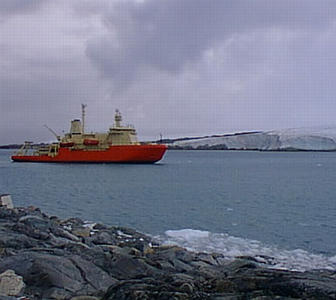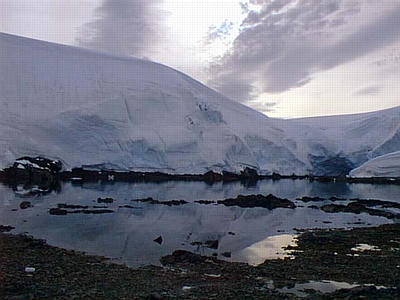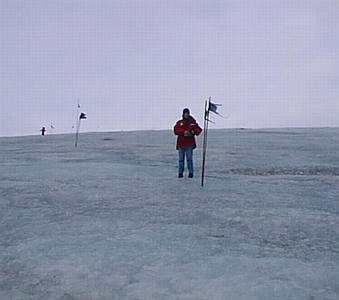
|
|
22 March, 1999
March 22, 1999
Hello from the Drake Passage! When I woke up this morning, the Antarctic
Peninsula was no longer visible. We are now in the Drake Passage, and
we're traveling north toward Punta Arenas, Chile. We still have about two
and a half more days of travel before we arrive. It's really weird to be
leaving. We are still keeping log every 15 minutes, but that will only
continue until sometime tonight. Once you are within 200 miles of a
country, you are not allowed to continue gathering data. Tomorrow, we
won't even be taking log. We will, however, still be editing data (ping
editing) as well as packing for the trip home. As you can probably
imagine, we have lots of stuff to pack up from our six weeks at sea.
Let's take some time to look at yesterday's question, "Who was Francis
Drake?" Francis Drake was the second person to circumnavigate (go all the
way around) the world. But before we talk about him in detail, let's get
some historical perspective. The early Greeks theorized that there was a
southern continent in order to "balance" the weight of the lands in the
northern hemisphere. Aristotle (384-322 BC) reasoned that since the
Northern Hemisphere lay under the constellation of Arktos, the Bear; then
the unknown land to the south must be the total opposite . . . Antarktikos.
The Egyptian geographer, Ptolemy (150 AD), named this unknown southern land
"Terra Australis Incognita." Although we know today that Antarctica does
not exist as a balance to the Northern Hemisphere, this belief kept early
explorers searching for this unknown land.
In 1588, Vasco da Gama went around the Cape of Good Hope (the southern tip
of Africa) and reached India. This helped geographers to understand that
Africa was actually connected to the known world; and that Terra Australis
Incognita, if it really existed, must be connected somewhere else (if at
all). In 1519, Portuguese Ferdinand Magellan became the first person to
lead a voyage to circumnavigate the globe. On his way, he found a small
waterway connecting the Pacific and Atlantic oceans that cuts through the
tip of South America. This narrow strip of water is now called the Strait
of Magellan, and we'll be driving through it in just a few days. By going
through this small waterway, however, Magellan was not able to prove
whether or not Terra Australis Incognita was actually connected to the land
south of the strait.
Englishman Francis Drake was sent to the South Pacific Ocean in 1577. He
was to enter the Pacific Ocean through the Straits of Magellan and explore
the southern coastline to find the great southern continent. Although he
didn't know it at the time, it could be said that Drake led the first
Antarctic expedition. He reached the Straits of Magellan on August 17,
1578, and they encountered their first penguins a week later. On September
6, 1578, the small fleet cleared the strait . . . but the next day they
were hit by a severe storm and blown off course. They ended up going
around Cape Horn (the southern tip of South America) -- proving that the
southern continent was not connected to any part of South America. The
waters between South America and Antarctica are named the Drake Passage
after this famous explorer.
One other early explorer who's very important to mention is James Cook.
James Cook actually circumnavigated the world three times between 1768 and
1779, and he was the widest-ranging explorer who ever lived. During his
first voyage, he discovered the whole east coast of Australia and the
islands of New Zealand. On his third voyage, he explored the Arctic coasts
of North America and Siberia. On his second voyage, he penetrated further
south than any other person before him -- making him the first person to
cross the Antarctic Circle. He discovered both South Georgia and the South
Shetland Islands. He was also the first person to sail all the way around
the continent of Antarctica. Ice, however, prohibited him from getting
close enough to ever see the continent itself. His journal was so
pessimistic about the cold, windy, icy conditions that he actually
discouraged other explorers from seeking the great southern continent for
decades after him. His observations about large numbers of seals and
whales, however, brought lots of people from many different countries who
were interested in making a profit off the wildlife. Nearly a third of the
subantarctic and Southern Ocean islands were discovered by sealers.
Antarctica itself, however, remained unspotted until 1820 (see journal
entry for March 13).
Well, now that you know how the Drake Passage received it's name, I have
two other questions for you. "Why is the Drake Passage known for commonly
having very rough seas?", and, "What kinds of things should be done on a
ship in order to deal with such conditions?" We'll look at those answers
in tomorrow's journal. You are still welcome to send email questions to me
through Wednesday night or Thursday morning. Also -- if you've sent a
question and didn't receive a reply, please send it again. Lots of mail
has gotten "lost" between the U.S. and the ship. We'll continue our
adventures from the Southern Hemisphere tomorrow . . .
Kim Giesting
Latitude: 59 degrees 59 minutes South
Longitude: 63 degrees 21 minutes West
Temperature: 2.9 degrees Celsius
Barometer: 986.7 mb
Wind Speed: 26.8 knots
Wind Direction: 323 degrees (from the Northwest)
Sunrise: 07:11
Sunset: 19:25

This is a picture of the Nathaniel B. Palmer as taken from Palmer Station just a few days ago.

Yesterday's scenery at Nansen Island was absolutely gorgeous!

Here's Julia standing on the glacier that's behind Palmer Station.
Contact the TEA in the field at
.
If you cannot connect through your browser, copy the
TEA's e-mail address in the "To:" line of
your favorite e-mail package.
|
